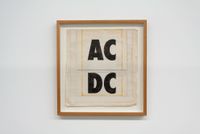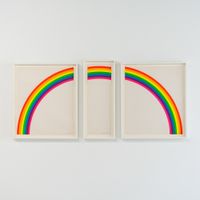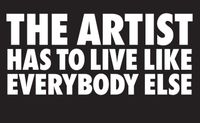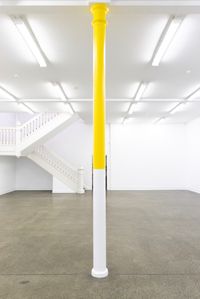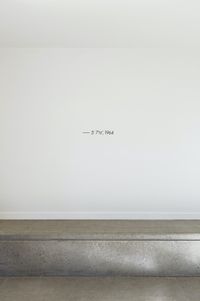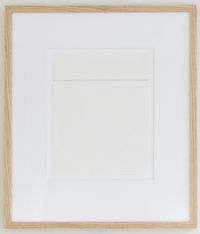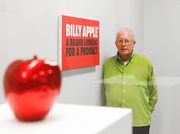Billy Apple was a pioneer pop and conceptual artist who, though born in New Zealand in 1935 as Barrie Bates, reinvented himself in 1962 as 'Billy Apple' after studying graphic design at the Royal College of Art in London. The change in name (accompanied by dyed-blonde hair) exemplified Apple's interest in the mechanisms of commerce and branding. His constructed identity became a marketing device for which he later developed a fruit-shaped logo then internationally registered as a trademark in 2008.
Read MoreApple's 'folksy' first name and vegetative surname were irrevocably merged with his artist's body (and new persona) to become an artwork. All activities undertaken by that body—such as cleaning windows or vacuuming the floor—and its by-products-like nasal mucus, semen, earwax or faeces—in the early 1970s became artworks too. No matter how difficult, they were works that could eventually be sold through dealers and galleries.
In the early 1980s, Apple began to look at the underpinning principles of fiscal exchange dominant in the art world by presenting neatly designed screenprints or paintings—executed by professional sign writers—of text that articulated the conventions of capital transactions such as selling, bartering, IOUs, commissioning or the paying of the artist's bills. The text paintings or prints stated the rudimentary details of each transaction. With this system, Apple shrewdly used the brand to perpetuate itself by drawing in funds from the sales of the works to sustain the thinking body that drove the brand. More recently and to the same end, he has sold conceptually connected products like Billy Apple Cider, or specially grown fruit, Billy Apples.
Such an interest in perpetuation applies beyond the brand to versions of Apple's physical body as well. In particular, four works shown in his 2018 solo exhibition Billy Apple Six Decades 1962–2018 at Rossi & Rossi in Hong Kong dealt with immortality. The two paintings (The Artist Will Live Forever, 2016 and I Consent, 2009/2015), video (The Immortalisation of Billy Apple Stage Two, Billy Apple Cell Line, 2010), and photograph (The Immortalisation of Billy Apple, 2009–15, 2010), reference Apple's 2009 gifting (as part of a collaboration with geneticist Dr Craig Hilton) of samples of his somatic cell tissue in 2009 to a Massachusetts research organisation and an Auckland laboratory. In both places, the cells are kept alive in special incubators and are studied for cancer research, genetic analysis and possibilities for cloning.
Apple collaborated with scientists on several occasions. In 2016, he began a project with Dr Justin O'Sullivan, a molecular biologist connected to the Liggins Institute at the University of Auckland, who is interested in the bacterial mini-ecosystems in various human body parts, including the gut.
For a project that spans 46 years, Apple twice provided samples of used toilet paper (in 1970 and 2016) to be analysed to see the degree of difference. Of interest to O'Sullivan is how some microbes seem to be selected by each person's genetic make-up to stick around over the course of decades.
The 1970 toilet paper was part of Apple's Excretory Wipings, 18 May–21 October 1970 project, originally exhibited in New York in 1971 and later shown briefly in a 1974 Serpentine Gallery survey before being shut down by the London authorities. A new work resulted from his collaboration with O'Sullivan, titled N=1 (2018), which incorporated an analysis of the microbial changes in a chart. The two-panel work was donated by Apple to the Liggins Institute.
Before his passing in September 2021, Billy Apple held numerous solo exhibitions including Head Height and other self-portraits, Hamish McKay, Wellington (2021); Billy Apple® is N=One, Starkwhite (2019); Billy Apple: The Artist Has To Live Like Everybody Else, Auckland Art Gallery Toi o Tāmaki (2015); Billy Apple: British and American Works 1960–1969, The Mayor Gallery, London (2010); Revealed / Concealed, Witte de With Center for Contemporary Art, Rotterdam (2009).
John Hurrell | Ocula | 2021
